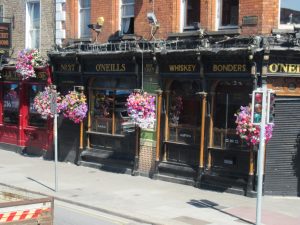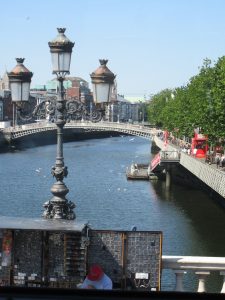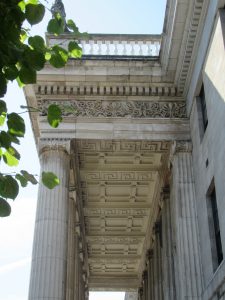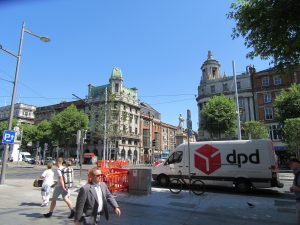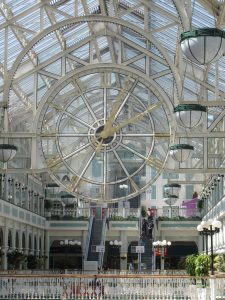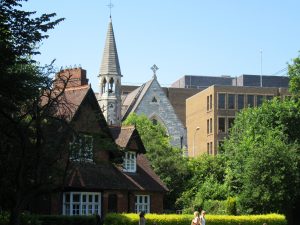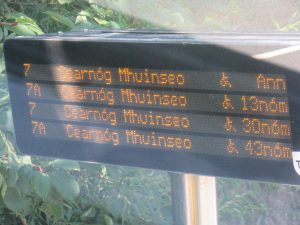Many moons ago I left you contemplating Oscar Wilde (‘the queer with the leer’) lounging around his rock in his smoking jacket. The man was a lush but he gave the world such pithy observations as: ‘I can resist everything except temptation’, ‘Work is the curse of the drinking classes’, ‘Some people cause happiness wherever they go; others whenever they go’, and my personal favourite, ‘Being Irish, he had an abiding sense of tragedy that sustained him through brief periods of joy’, so he earned his keep.
But we must move on and leave him to it. Oscar hangs out in Merrion Square and his story ‘The Selfish Giant’ provides the theme for the playground there, The Giant’s Garden. It is wonderful, all wood and whimsy.
We pass down Westland Row, dating from 1776, and past the large and pillared St Andrew’s Church and a business still showing its pride before swinging past O’Neill’s Whiskey Bonders. Irish whiskey has an ‘e’; Scotch whisky does not. You learn something every day.
We trundle past an eye-catching paint job and a rabbit (possum? Squirrel? I realise I haven’t given you the best picture to judge from) and the City of Dublin Steam Packet Company, home to a shipping line that ran between Britain and Ireland from 1823 to 1922. Its most lucrative route was the mail line from Dun Laoghaire to Holyhead. This was served by the ‘Province’ ships: the Leinster, Ulster, Munster and Connaught, named for the four provinces of Ireland. They also used the Llwywyllyn, because if there’s any language more like what happens when most of the letters have broken off your keyboard than Irish, it’s Welsh.

On October 10 1918 – just four weeks before the armistice that ended World War One – the Leinster was torpedoed by a German U-boat as it headed out of Dun Laoghaire harbour on the way to Holyhead with its load of mail. It sank in 30 metres of water taking over 500 souls, mostly troops from around Dun Laoghaire, with it. It was the second ship the Steam Packet Company had lost to German torpedoes and it remains the greatest maritime disaster in Irish seas. The shipping line couldn’t recover financially and was liquidated in the 1920’s.
Dun Laoghaire houses the National Maritime Museum in a decommissioned church full of model ships, lighthouse lights, beautiful stained glass and all sorts of old record books, as well as photos of the aftermath of the sinking of the Leinster and identity cards from many of the lost soldiers and sailors. Most were local and the people who organise these sorts of things are already planning the centenary commemorations for next October. Some of those who died will still have family living locally; it’s that sort of place.
And finally we get to the River Liffey.
There are many picturesque bridges over the Liffey, as well there need to be because most were put there in the days before cars were born or thought of, so they tend to be pretty narrow and this does not do good things for inner-city traffic flow. There are one or two newer ones like the Samuel Beckett bridge, designed to look like a harp. This swings back to let river traffic pass and I was told by a tour guide, although I don’t know if it’s true, that for important occasions they can loosen the tension on the struts slightly which causes them to vibrate with the wind and play a chord. As you can surely tell, I did not take this photo. I could have, you know, but I didn’t.
Also one of the newer parts: a footbridge complete with seating and the ever-present flowers.
The Ha’penny Bridge, a footbridge built in 1816 in Shropshire using ore mined in County Leitrim. Previously to travel from one side of the river to the other you used a ferry, one of seven operated by a Mr William Walsh, and paid a ha’penny for the privilege. The ferries eventually became a bit unseaworthy and Mr Walsh was told that he could replace them or build a bridge. He chose the bridge. He was allowed to charge a ha’penny toll from anyone crossing it for 100 years on the condition that if the citizens of Dublin found the bridge and toll to be ‘objectionable’ within the first year it was to be removed at no cost to the city. I’m not sure how Mr Walsh was supposed to collect the last few years’ worth of ha’pennies although given the fact that the many ghosts of Dublin and their doings appear to be fairly widely accepted, perhaps nobody saw a problem. Clearly the shoppers and workers didn’t object because the bridge stayed and the toll was dropped in 1919.
We now get off the bus on O’Connell Street, the main thoroughfare dating from the 17th century. It’s very wide and was upgraded in the late 18th century (mostly by knocking down anything in the way) to become, at the time, one of the finest streets in Europe. It has a strip down the middle with monuments along it, and trees along the sides. It features the grand GPO, headquarters of the 1916 Rising and with the bullet holes still in the plasterwork to prove it.
Most of this was, of course, destroyed in 1916 and rebuilt in later years.
We pass Dr Quirkey’s Good Time Emporium and reach the Millenium Spire, erected in 2003. 
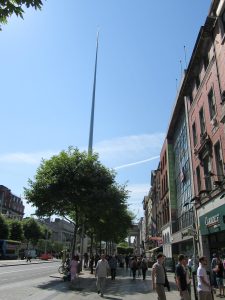
The spire (‘the stiffy by the Liffey’), is built on the site of the former Nelson’s Column, blown up by the IRA in 1966 after watching over central Dublin for 150 years. The next occupant was Anna Livia, the floozie in the jaquzzi, who was moved further out of town because of her little bubble problem. The spire is pretty cool up close. They’ve done interesting things with the texture of the metal. At night the base is lit, and the top ten metres have over 11,000 little holes through which LEDs glow. For special occasions the colour is varied – on St Patrick’s Day the whole thing turns green, for example. The kids call it the Light Sabre.
O’Connell Street is the home of Daniel O’Connell, called ‘The Liberator’ and ‘The Emancipator’ for his lifetime of work towards political reform and the emancipation of Catholics from the oppression of the Protestant Ascendancy. At one point he was challenged to a duel by a political opponent, and the British Government administration had high hopes that it would be the end of him. Daniel O’Connell won, however, and having killed a man weighed on his conscience so heavily that he offered to ‘share his income’ with the man’s widow. She declined but accepted an allowance for her daughter, which he paid for the thirty years until his death.
We also have Charles Stewart Parnell, a Protestant who was one of the most influential politicians of his time and fought for home rule. Unfortunately he was a bit of a hard dog to keep on the porch and his career unravelled toward the end when his long adulterous love-affair became public knowledge.
Then there’s William Smith O’Brien, born into the Protestant landed gentry in 1803 and a direct descendent of the 11th century High King of Ireland, Brian Boru. He was a lawyer, a member of parliament and a Daniel O’Connell supporter. He campaigned for Catholic emancipation, the revival of the Irish language, and famine relief, among other things. In 1848 he led landlords and tenants in an uprising and was convicted of treason. He was sentenced to be hanged, drawn and quartered but following a petition for clemency signed by 70,000 people in Ireland and 10,000 in England the sentence was commuted to transportation and he was sent off to Tasmania. He was eventually pardoned and returned to Ireland for the last few years of his life.
There are a few more but I think we’ll keep moving. We’ll head south down O’Connell Street and turn onto the Quays, along the Liffey. There’s the Viking Splash tour going past in their lovely Viking helmets, which apparently the Vikings didn’t really wear apart from special occasions, weddings and Bar Mitzvahs and things.
Here are The Hags With The Bags (apologies to the lady in blue, I didn’t mean you)
and the Ha’Penny Bridge. Luckily they’ve removed the turnstiles because I don’t have a ha’penny on me just now.
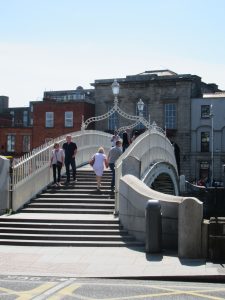



Now we’ve crossed the river and we’re heading through the archway into Temple Bar, one of the older and more atmospheric parts of the city.



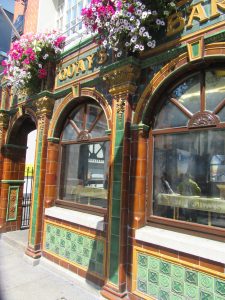
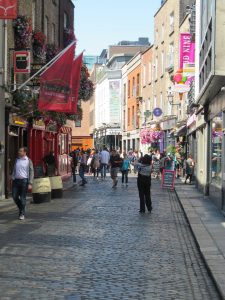

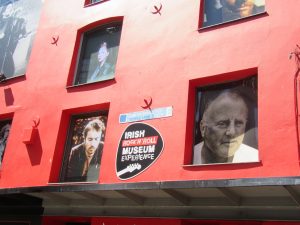

This window is filled with stuff. I don’t know why.




And here we are at the Tart With The Cart, the Dish With The Fish, or the Molly Malone statue, take your pick.
Molly Malone sold cockles and mussels alive, alive-o, until she died of the fever (or something – she’s rumoured to have been a lady of flexible virtue) and returned as a statue whose generous bosom is said to give good luck. See how her boobs have been rubbed into a different colour? Yup.
We’ve passed a Dublin Bike bike-borrowing point and a fair few bars and restaurants and we’re now in Grafton Street, my favourite and lots of other people’s too. I was trying to take a picture here of the lovely colourful flower market but all these people selfishly kept on walking.


There’s always something going on here. Many somethings, usually. Buskers, street artists, all sorts. Today it’s this guy who’s very, very funny and good at what he does. Back when we were newly arrived and living just off Grafton Street the kids and I came across him right at the start of the performance and got a space in the inner circle. There’s a point in his act where he chooses a child to help him and he picked Noah. Noah was a good choice because he has no shyness at all and is very expressive and, just by so obviously enjoying himself, got quite a following of his own and was well applauded. I think I mentioned back in the post about Singapore that when we were at the Swimming Pool of Great Excellence I spent a lot of time standing under the rain-shower part of the lazy river because I’d discovered that the water somehow washed away all the tension and stress and worry of the last few weeks. Well, this guy did the same thing. We’d lived in six temporary places since leaving home, we were dealing with choosing a house and schools and sorting out bank accounts and immigration and all the rest, and on this day we were walking home from a visit to the Disney shop (kiddie catnip, I’m telling you) and came across the man with the 15-foot unicycle, flaming torches and endless patter. And I laughed and laughed and laughed for the full hour and everything went away and I emptied my purse into his hat (have a can of Coke for yourself, good man) and went home feeling much lighter. 
Sometimes it’s giant bubbles you come across, sometimes it’s sand sculpture. There’s usually someone with an accordion or a tin pipe. Sometimes you just get a free ride in a turn-upside-downer.
Now we’re heading into St Stephen’s Green shopping centre for a spot of lunch. It’s quite flash in here. Many windows. The toilets could be more conveniently located though.
I can still watch Mr Unicycle as I eat. Good score.
I also have a view of the St Stephen’s Green gate, the Fusiliers’ Arch, built in 1907 in memory of those from the Royal Dublin Fusiliers who died in the second Boer War. The red hot mess in front of it is what will be the cross-city Luas (tram) line.
Dublin used to be well-served by trams until they were all phased out in the 50’s. Then someone thought, you know what would be great to have? Some trams! So two lines were built, one arterial route to the south and one to the west, in 2004. But here’s the thing: it didn’t occur to anyone until some time later that it would be super handy if they met in the middle. It’s quite a hike to get from the Red line to the Green line in the central city. For the last four years, then, the entire place has been a mess of road works and diversions and mud and machinery and general angst and inconvenience.
The cross-city line is due to open on December 9 and they’re currently in the testing phase which involves trams tootling around with men in boiler suits on board holding clipboards. I was doing a spot of Christmas shopping the other day and here’s my prediction: the noses of the shiny new trains are going to be very quickly covered in bits of people. The line goes down O’Connell Street, past Trinity College and in general through all the places that are packed with people, mostly tourists and mostly wandering all over the road. The trams are everywhere and they’re electric so they’re very, very sneaky. Until they start playing tunes like Mr Whippy vans it’s going to be splat city. You heard it here first.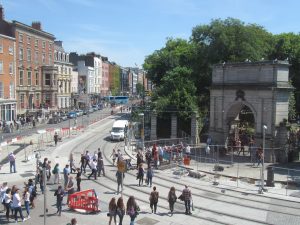
We don’t have time to go around St Stephen’s Green, lovely though it is. We’ll just pop into the nearest entrance while we wait for the Luas (Irish for ‘speed’, in case you were wondering).
A fair bit of 1916 Rising action took place in the park. This poor man was the first to be killed, shot by, among others, our old friend the Countess Markievicz.
My favourite story of that particular time is this one. The opposing forces were housed on either side of the park, the Irish Citizens’ Army in the Royal College of Surgeons building and the British forces in the Shelbourne Hotel. The one and only thing they agreed upon was that at 2 p.m. every day there should be a ceasefire to allow James Kearney, park keeper, to feed the ducks. He did this for the duration and, ceasefire or not, it must have taken guts because you never know when some nutcase is going to get a bit trigger-happy. He reported that the various water animals seemed ‘very little perturbed by the bullets flying over their heads’, although I believe there one or two duck fatalities. Mr Kearney was later awarded ‘a parchment certificate for bravely feeding the waterfowl under fire’.
And now we’ll catch the tram. I enjoy the tram, it’s faster than the bus and far more modern and comfortable than the train, and I especially like the way the carpet stuff on the seats has Dublin icons printed all over it. Is that attention to detail or what?
And it gives you really easy-to-follow etiquette lessons.
 I don’t know how well it works though. When I was a pregnant person (there are posters for them too) people giving me seats on the bus were few and far between. You had to be a nun to get that kind of treatment.
I don’t know how well it works though. When I was a pregnant person (there are posters for them too) people giving me seats on the bus were few and far between. You had to be a nun to get that kind of treatment.
Fifteen years ago, as an aside, nuns were plentiful around these parts. I’d see them often around town and on buses. They were all old, and now I hardly see nuns at all. I think my nun tally is three, in almost two years. They’re an endangered species. Funny that.
What I’m aiming to show you with most of these is how close we are to not being in a city at all. That’s the wilds of Wicklow just right there. It’s nice, reminds us of home.
And here we are, Bride’s Glen, the end of the line. We can see the sea again, and Killiney Hill, our local park and obelisk, as we catch the number 7 bus for the final leg of the trip.
I should really find out where that path goes to. It might be a good bike ride.
Now we’re passing Kilbogget Park, great place to come for a play and a bike ride and all the things.
Last year Noah was invited to a First Communion party at the rugby club here. We didn’t know anything about communion parties. Do you dress up or wear play clothes? Is a gift required? A card? I asked a teacher, who didn’t know either because they’re a new phenomenon, arriving with the recent boom times. I did know, from noseying into people’s gardens during communion season (May), that they are a very big deal. Apparently the average cost of a First Communion is €700. That is a lot of euros. Girls are dressed up as little brides (and yes, I know it’s not enlightened, on so many levels, to say this but the communion dress section in Debenhams is to die for) and the boys in suits. The mam has to go to the beauty parlour and the hairdresser and have a new outfit. There are bouncy castles. This particular party had a done-to-the-nines mam, balloon arches, what looked like catered food, a beautiful bakery cake and a stretch limousine with champagne (I’m hoping it was really sparkling apple juice) and one of those static ball things that makes electricity go to your fingertips when you touch it. The kids were taken for rides around the block in the limo and Noah thought the whole deal was the bees knees.
So they ate, rode in the limo and played on the playground before I picked Noah up. We were standing at this bus stop here and he was describing the food to me. Noah eats like a horse. He ate chicken wings and rice and what sounded like a decent savoury lunch. Then he ate lollies. Then, as he was telling me about this concoction that looked like an ice cream in a cone but was in fact a cup cake in a cone with what must have been most of its weight in icing swirled on top, he started looking a bit green. Then he power-puked all over the footpath. Then he did it again. And again. And again.
I didn’t know what to do. I’m always disgusted with vomit on the footpath, assuming it was some drunk guy being obnoxious. I had a few close calls myself during my first pregnancy so I should know better, but I’d blanked that out. There was mess everywhere and it’s not like I had a hose handy. I did the obvious thing and got the heck out of Dodge.
I use buses a lot and have no wish to be blackballed for bringing a child on board to blow chunks in the aisle. Noah, I decided, would be better walking. It’s not that far and it was a nice enough day. A minute later a car pulled up beside us carrying a middle-aged lady and her mother, both looking very concerned. The window went down. I see your boy’s not well, said the lady. Can we give you a ride home?
Well, reader, I was blown away. I never even want to take my own puking children in my car, let alone someone else’s. Can you imagine? That’s very kind, I said, but he might make a mess in your car, and I’d hate that. It’s no matter, sez the lady, I’m not worried. I’ll be happy to take you.
And she really looked like she meant it. Her mother was nodding along earnestly. So I asked Noah whether he’d like to drive home or walk. He was feeling better in the fresh air and opted to walk, so they ladies handed me a box of tissues – very welcome indeed – and went on their way. It was the kindest offer I’ve had in a long time, let me tell you. A stranger and their puking kid. That is sacrifice indeed.
By the time we got home Noah had made a full recovery and was asking for his loot bag – that was a firm no – and it rained the next day which made me feel a bit better about the footpath. As I pass the scene of the crime now I think ah, isn’t it lovely that we’ve been here long enough now to have made all these memories?
See what they did there? Solar panels built right into the roof tiles on every house in the development.
Flowers on the fence. Well, we couldn’t have a square metre without flowers, could we?
Our local pub, the Graduate (very good roast meals, if you’re in the area) and the SuperValu, our closest supermarket.
Then we’re off the bus in Sallnoggin, just in time to meet Cassia and Noah after their summer programme. We have Our Lady of Victories, the church attached to the kids’ schools, and Our Lady herself, the Blessed Virgin Mary. You probably can’t tell from the photo but that’s a big carpark and it’s full every weekday morning for the 8:45 mass. It’s mostly the Nissan Micra and Toyota Yaris brigade, to be sure, but the faithful still flock to the Catholic churches.
Here we have Chillicious, ice cream parlour of supreme wondrousness, and the local funeral parlour. I’ve included that one because I like the shape of Irish hearses.


Yes, I know your poor eyes are bleeding. I have mercy. We’re almost home.
There you go. A day meandering around town with me. What I hope you’ve got from all this is how much I love Dublin. I find it infinitely fascinating, rich with story and culture and surprise, colourful and wonderful. My soul is most at home on Aotearoa’s east coast where I was born and raised, but my heart belongs to Dublin.
And, because it was on the end of the roll of film, so to speak, here’s a bonus one: Cassia loving her new swimming goggles just so much.




